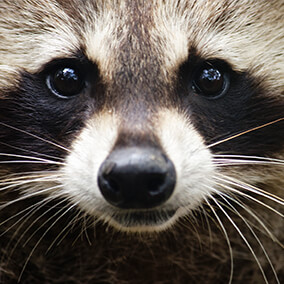
North American raccoon

Mammals


Stable
facts


Raccoons eat whatever they can get. They’ll eat crayfish, berries, birds, acorns, insects, eggs, fish, fruits, frogs, lizards, and small mammals.

Raccoons live just about anywhere there’s water: swamps, marshes, prairies, around streams, and along shorelines. They sometimes find their way into farmlands, suburbs, and cities.
description

Night life
At night, raccoons are out and about, but you probably won’t see one during the daytime. They spend their days snoozing. Sleeping spots are often in a hollow tree, under a log or a rocks, or in a burrow made by another animal.

Not in the house!
Raccoons have adapted to living near humans. Sometimes, they cause damage and problems for people by cozying up inside storage buildings, attics, and garages. They can be a nuisance for farmers when they raid crops and chicken yards. Still, they play an important role: they help control rodent populations.

Nimble fingers
A raccoon’s quick fingers pluck mice and insects from their hiding places and raid nests for tasty eggs. In the water, they easily grab crayfish and frogs. This adaptation also makes it easy for them to open garbage cans, untie knots, turn doorknobs, and even open jars!

Little kits
A baby raccoon is called a kit. Female raccoons usually give birth to a litter of kits every spring. A newborn racoon is blind and helpless, and it has hardly any fur. It opens its eyes for the first time when it is about three weeks old. Then, it grows quickly! By the time it is seven weeks old, it can run and climb. Young raccoons live and travel with their mother for almost a year.














